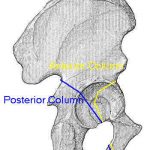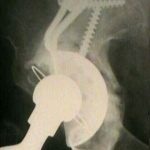Discussion
(see also: classfication and bone graft options)
- condition in which superior aspect of pelvis is separated from inferior aspect because of bone loss or a fracture through acetabulum;
- most discontinuities represent unhealed transverse acetabular fractures which occurr through areas of pelvic bone loss;
- in the study by Berry, et al (1999), the authors identified 31 cases of pelvic disontinuity out of 3505 (0.9%);
- much more common in women than men, and is more common in rheumatoid arthritis;
- radiographs:
- fracture line through the anterior and posterior columns;
- medial translation of inferior aspect of the hemipelvis relative to the superior aspect (look< for break in Kohler's line);
- on AP view rotation of inferior aspect of hemipelvis relative to superior aspect (asymmetry of obturator rings);
- other radiographic indications include:

- rotation of the inferior aspect of the hemipelvis relative to the superior aspect (seen as asymmetry of the obturator rings);
- w/ suspected pelvic discontinuity, consider need for CT scan;
- references:
Technical Considerations
- treatment may require insertion of posterior column reconstruction plate and a gap cup
- intra operative exam findings:
- observe for motion between the superior and the inferior hemipelvis when applying a caudal stress to the ischium with a blunt elevator;
- w/ discontinuity and severe segmental bone loss and/or cavitary bone loss have worse prognosis than those w/o bone deficiencies;
- reconstructive surgery which resulted in healing of the discontinuity generally was associated w/ good results;
- w/ simple discontinuity, consider use of posterior column plate to stabilize the pelvis and a porous-coated socket inserted without cement;
- w/ segmental deficiency, consider use of an antiprotrusio cage augmented w/ particulate bone graft or a single structural bone graft;
- sciatic nerve: requires protection throughout the case
outcomes
- antiprotrusio cage
- Construct Rigidity: Keystone for Treating Pelvic Discontinuity.
- Burch-Schneider antiprotrusio cage was used to reconstruct 13 hips, and the socket remained stable in all thirteen;
- in 11 hips, the discontinuity definitely (six hips) or possibly (five hips) healed;
- in 11 hips there was a satisfactory result;
- pitfalls:
- insertion of socket with cement w/ anterior and posterior plates used to secure the discontinuity;
- 5 hips had insertion of a socket with cement and two plates without use of an antiprotrusio cage;
- none of these hips had a satisfactory result (4 hips had failure because the socket loosened;
- ref: Reconstruction of AAOS type III and IV acetabular defects with Ganz reinforcement ring: high failure in pelvic discontinuity.
Recognising & Treating Pelvic Discontinuity: Run or Refer
- Acetabular revision using a trabecular metal acetabular component for severe acetabular bone loss associated with a pelvic discontinuity.
- The treatment of acetabular bone defects with an associated pelvic discontinuity.
- The treatment of pelvic discontinuity during acetabular revision.
- Revision surgery in pelvic discontinuity: an analysis of seven patients.
- Reconstruction of major column defects and pelvic discontinuity in revision total hip arthroplasty.
- Bridging massive acetabular defects with the triflange cup: 2- to 9-year results.
- Identification and management of pelvic discontinuity.
- Pelvic reconstruction for massive acetabular insufficiency
- Early postoperative transverse pelvic fracture: a new complication related to revision arthroplasty with an uncemented cup.
- Acetabular revision using an anti-protrusion (ilio-ischial) cage and trabecular metal acetabular component for severe acetabular bone loss associated with pelvic discontinuity.
- Acetabular component revision in total hip arthroplasty. Part II: management of major bone loss and pelvic discontinuity.
- The Reconstruction of Periprosthetic Pelvic Discontinuity
- Acetabular Distraction: An Alternative for Severe Defects with Chronic Pelvic Discontinuity?
- The challenge of pelvic discontinuity. Cup-cage reconstruction does better than conventional cages in mid-term


